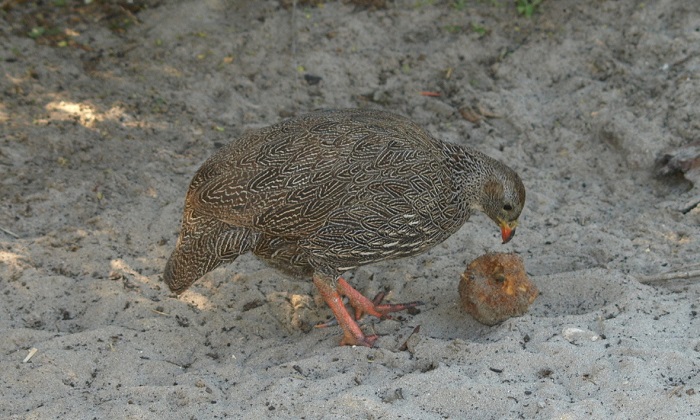Cover image of Cape Spurfowl by Terry Terblanche – Near Lutzville, Northern Cape – BirdPix No. 260909
The Cape Spurfowl is a member of the ‘vermiculated group’ of spurfowls and francolins, with the Natal Spurfowl (Pternistis natalensis) as its closest relative. The Cape Spurfowl is the largest spurfowl in southern Africa.
Identification
The sexes are alike in appearance, but males are considerably larger than females and have larger spurs on the legs.

Kogelberg Nature Reserve, Western Cape
Photo by Desire Darling
From a distance the Cape Spurfowl appears dark brown overall, and without distinctive facial markings. The upper parts are brown, intricately patterned with off-white chevrons. The crown is distinctly darker, giving a capped appearance. The throat is white with scattered black flecks. The feathers on the underparts, including the neck, upper breast and flanks are brown, intricately patterned with parallel, whitish chevrons. The plumage on the lower breast and belly has additional broad white central streaks. The legs and feet are dull orange-red.

Rietvlei, Western Cape
Photo by Gregg Darling
Juveniles resemble the adults but are duller overall.
The Cape Spurfowl is not likely to be confused with any other spurfowl due to its large size, overall dark colour and lack of red facial skin. It most closely resembles the Natal Spurfowl (Pternistis natalensis) and the Red-billed Spurfowl (Pternistis adspersus), however the range of the Cape Spurfowl does not overlap with these two species.

Langebaan, Western Cape
Photo by Lance Robinson
Status and Distribution
The Cape Spurfowl is a common to locally abundant resident. It is endemic to southern Africa, occurring mainly as a fynbos endemic, with seemingly isolated populations in Namaqualand and along the Orange River to Prieska. It occurs marginally in extreme southern Namibia along the Orange River.

There is no evidence of range contraction and the Cape Spurfowl is not considered threatened. The species has benefited from habitat transformation because of its ability to colonise alien vegetation and suburban parklands. However, in agricultural lands it is impacted by the severe fragmentation of natural patches of habitat.
Habitat

Montagu district, Western Cape
Photo by Karis Daniel
The Cape Spurfowl’s preferred habitat is coastal and montane fynbos, especially strandveld and renosterveld. In drier areas in the surrounding Karoo it is found in riverine scrub along drainage lines. It has adapted well to exotic Acacia thickets, as well as farmlands, parks and gardens. Its presence on farms and in suburban areas is dependent on pockets of natural vegetation in which to roost and breed.

Kirstenbosch National Botanical Garden, Western Cape
Photo by Neels Jackson
Behaviour
The Cape Spurfowl occurs in pairs or small coveys of up to 20 birds. It is a conspicuous species and its presence is often revealed by its call. They become tame and confiding around people, foraging in the open, and even approaching humans and flying onto picnic tables to scavenge food.
When alarmed, the Cape Spurfowl erects the crown feathers. It flies well but is reluctant, preferring to run into cover when disturbed. Coveys may sometimes perch in trees after they’ve been flushed but are more likely to land on the ground before fleeing into dense cover.

Koringberg, Western Cape
Photo by Les Underhill
The Cape Spurfowl is very noisy during the early morning and late afternoon. They roost at night huddled together on the ground and sometimes in trees or in reedbeds. The Cape Spurfowl regularly dustbathes in fine dust and gravel. Drinks mostly during the late afternoon.

Langebaan district, Western Cape
Photo by Graham Bull
The Cape Spurfowl forages in the open but is rarely found far from cover. They search for food by scratching in leaf litter and loose soil. Its diet is varied. During summer they feed primarily on invertebrates like insects, small snails, termites and ants. They also readily consume fallen fruit, including grapes, apples and pears. In winter the diet mainly consists of fresh shoots, leaves, bulbs, corms, seeds, berries and fallen grain. It sometimes also scratches through the dung of large herbivores in search of grubs and undigested seeds.

Witsand district, Western Cape
Photo by Johan and Estelle van Rooyen
The Cape Spurfowl breeds from August to January. It is a monogamous, solitary nester. The nest is a shallow scrape on the ground, thinly lined with grass stems and occasionally feathers. The nest is well concealed, typically under dense tangles of scrub.

Langebaan district, Western Cape
Photo by Graham Bull
Four to eight eggs are laid per clutch. Larger clutches of up to 14 eggs are probably laid by two females. The eggs are brownish cream to pale pink.

Langebaan district, Western Cape
Photo by Graham Bull
Incubation begins once the full clutch has been laid. The incubation period lasts from 22 to 25 days and is performed entirely by the female. Newly hatched young are precocial but chicks are still brooded by both adults, with possible cooperative brood care by related hens.

Tygerberg Nature Reserve, Western Cape
Photo by Gerald Wingate
Further Resources
Species text from the first Southern African Bird Atlas Project (SABAP1), 1997.
The use of photographs by Desire Darling, Gerald Wingate, Graham Bull, Gregg Darling, Johan and Estelle van Rooyen, Karis Daniel, Lance Robinson, Les Underhill, Neels Jackson and Terry Terblanche is acknowledged.
Virtual Museum (BirdPix > Search VM > By Scientific or Common Name).
Other common names: Cape Francolin (Alt. English); Kaapse fisant (Afrikaans); Kaapse Frankolijn (Dutch); Francolin criard (French); Kapfrankolin (German); Francolim do Cabo (Portuguese)
A list of bird species in this format is available here.
Recommended citation format: Tippett RM 2024. Cape Spurfowl Pternistis capensis. Biodiversity and Development Institute. Available Online at https://thebdi.org/2024/03/20/cape-spurfowl-pternistis-capensis/

Witsand district, Western Cape
Photo by Johan Van Rooyen

